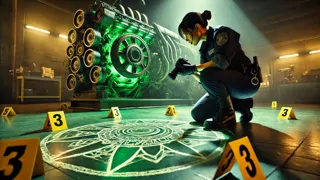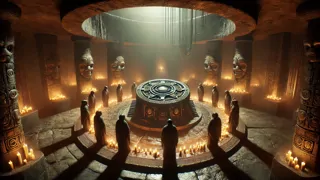Introduction
At the heart of New Tenochtitlan, a sprawling metropolis rising from the sun-scorched desert plains of what was once the American Southwest, the night air thrummed with distant thunder and the steady hum of concealed power. In this alternate United States, the rediscovered Aztec engine known as “The People’s Machine” fueled neon-lit districts, irrigated high-altitude terraces, and underpinned the prosperity of millions, bridging ancient glyphic alchemy and cutting-edge nanotechnology. Its obsidian gears, carved with serpentine glyphs and infused with crystal veins, pulsed with a jade glow beneath skyward solar arrays. Scholars debated whether the machine was a sacred gift or a blasphemous abomination, while magnates and secretive cabals schemed to claim its hidden designs. Before dawn, the body of Ilihua Montoya—an esteemed engineer—was found lifeless beside the engine’s core, his eyes reflecting its emerald light. Tasked with the investigation, Corporal Mara Reyes of the Federal Confluence Security Bureau dove into a web of political intrigue and cultural tension. Navigating catacombs beneath glass spires and enigmatic ritual chambers, she realized that solving this murder required more than forensic skill. It demanded decoding Aztec codes, confronting ancient rites, and balancing justice with reverence. In the neon jungles and shadowed pyramids of New Tenochtitlan, the search for truth would expose how The People’s Machine shaped not only machines, but the fate of an empire reborn.
The Discovery
Deep beneath the restored pyramid of Tlatelolco, a group of archaeologists and engineers uncovered the long-lost chamber that housed The People’s Machine. Torchlight danced off the obsidian walls, illuminating serpentine glyphs that spiraled toward a massive, gear-studded core. Each turn of those dark wheels seemed almost alive, pulsing with the memory of centuries. Researchers spoke in hushed tones as they mapped every etched symbol, certain that the engine contained instructions woven between myth and mathematics.

Surveyors raised scanning drones and holographic projectors to record the precise dimensions of the discovery site. The air smelled of warm stone and machinery warmed by residual energy. With each data sweep, the team uncovered fragments of an instruction set: how to channel solar arrays into pure mechanical force, how to fuse glyphic alchemy with crystalline crystals to produce a self-sustaining power cycle. They realized this was not mere legend—it was a blueprint for a civilization’s heartbeat.
Word of the find raced through New Tenochtitlan. From corporate boardrooms in sky-high towers to clandestine shrines hidden in the old city, the promise of unmatched power ignited passions of greed and devotion. By dawn, factions had staked claims, rumored alliances formed, and whispers of sabotage began to swirl. The chamber’s mysteries would not stay buried for long.
Shadows of Conspiracy
Corporal Mara Reyes arrived as forensic teams sealed the chamber. Her uniform contrasted sharply with the tribal patterns painted on the stone pillars. She moved methodically, photographing bloodstains that shimmered green under the engine’s residual glow. Footprints pressed into the sand-dusted floor led toward an access hatch, stamped with a glyph that matched those on the gears. With each clue, Reyes sensed a convergence of past and present—a conspiracy molding itself around the engine’s heart.

Interviews with the lead engineers revealed friction over public versus private control. One academic faction counselled transparency and scholarly study; another advocated closing the site to protect Aztec heritage. Corporate representatives arrived with legal briefs and armed agents, their silence a threat that only deepened the mystery. Reyes’s superiors urged caution, fearing that angering either side could ignite widescale unrest. Yet the evidence pointed not to a simple feud but to calculated betrayal.
At midnight, Reyes uncovered a hidden compartment in the engine’s pedestal. Inside lay shredded fragments of a journal, spattered with blood and written in a blend of Nahuatl and encrypted code. As she aligned the pieces under a magnifier, she realized the victim had been close to a revolutionary breakthrough. The secrets of The People’s Machine were as dangerous alive as they were dead, and someone was willing to kill to keep them hidden.
Ritual and Reckoning
Guided by the partial journal, Reyes discovered a sealed passage beneath the pyramid’s foundation. Torches flared as she descended into a stone circle carved with the visage of the Feathered Serpent. Masked figures chanted in the darkness, their voices echoing against obsidian walls. In the center, The People’s Machine lay dormant—its gears quiet, crystals dark. An ancient ritual circle surrounded it, etched in silver dust that glinted like starlight.

Reyes interrupted the ceremony, her voice cutting through the chant. Betrayal and fear trembled on masked faces as they recognized a guardian of the law. She demanded the mastermind reveal themselves, threatening to dismantle both the ritual and the engine. A tall figure stepped forward, cloak embroidered with glyphs no living scholar could fully read. He claimed loyalty to the forgotten bloodline of the Aztec emperors and vowed to awaken the machine’s true purpose—restoring the gods to their throne.
A struggle erupted beneath the temple floor. Sparks flew as bullets met stone; torches guttered in the skirmish. When the dust settled, Reyes stood victorious. The ritual artifacts lay scattered, and the engine’s core glowed with tentative life as she deactivated its final lever. With careful hands, she sealed the chamber again—this time under a new decree that the machine would serve all people, not just the powerful. Her report would shape the future of New Tenochtitlan, balancing reverence for a lost empire with the rule of law.
Conclusion
By dawn, the conspirators were in custody and The People’s Machine stood silent yet intact. In court, the evidence Mara Reyes compiled spoke of political ambition twisted into sacrilege, of a machine destined for unity rather than division. Revered scholars led panels on its safe study; community leaders designed open ceremonies to honor the Aztec legacy. New Tenochtitlan found hope in balance—technology tempered by tradition, power shared in service, and justice delivered for a fallen engineer who dreamed of progress. As the city’s neon glow returned to normal, Reyes watched the sunrise over the stepped pyramid, aware that history had pivoted on her choices. The People’s Machine would beat again under watchful eyes, a reminder that the future belongs to those who respect the past.


















